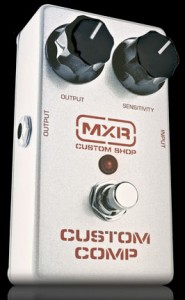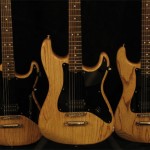Comp Lit, Pt. 3: MXR Custom Comp Review
I’ve always had a soft spot for MXR pedals. A Distortion+ mated to a Boss GE-7 were the key ingredients in making my silverface Twin sound like a Marshall, back in 1986! But over the years I’ve become, well, a snob. A “boo-teek” snob. I thought, Surely some huge company with a team of talented engineers and millions of dollars couldn’t build a pedal as well as some dude in his garage….
But then I tried the MXR Carbon Copy, the best value in a delay out there. So I thought, maybe I’ll give these scrappy underdogs from Benicia another chance. Would their latest compressor, the Custom Comp, be another home run? Only one way to find out.
Features
Basically, the CSP202 Custom Comp ($129.95 street) is a cross between a classic M-102 Dyna Comp ($69.95 street) and the reissue ’76 Vintage Dyna Comp ($174.95 street), but with a few smart tweaks thrown in.
The Custom Comp shares the basic layout of those two pedals: small but sturdy metal enclosure, big output and sensitivity knobs, metal switch, side-mounted jacks. Like the M-102 Dyna Comp, the Custom Comp has an indicator light and an adapter jack, modern amenities missing from its posh big brother, the script-logo CSP028 ’76 Reissue.
While the ’76RI sports nicer hardware than the Custom Comp, such as Switchcraft jacks and CTS pots, the ’76RI and the Custom Comp share the component that MXR made the biggest fuss about, which is the scarce CA3080 “metal can†IC Harris semiconductor. Besides being notable for its excellent slew rate (50V/µs), which makes them especially useful for multiplexer and fast unity-gain voltage followers, as I was recently discussing with my girlfriend over coffee, the CA3080 is known in semiconductor circles for its dynamic range, transparency and quiet operation.
The Custom Comp also has:
> True bypass, employing a proper TPDT switch.
> “RF suppression components,” and while I don’t know what exactly in particular those are, it should make it less likely that your pedalboard will pick up radio transmissions like Spinal Tap’s wireless units did when they played at that Air Force base with their non-regulation haircuts.
> The true mark of a boutique pedal: internal trim pots. Nothing is more high end, and less Boss, than internal trim pots.
It’s not hard to appreciate what Dunlop’s going for here: the tone of the ’76RI, but with modern amenities like true bypass, an indicator light and an adapter jack, all for less money. While there is some theoretical tonal or durability differences between the Custom Comp and the ’76RI, unless you have your own signature model Strat or really clumsy feet, you’re not likely to notice.
How’s It Work?
We’ll start with the controls. Output is just what it sounds like. Fully counterclockwise, the pedal is silent. Unity gain is around noon, depending on where the Sensitivity knob is. Diming the Output gives you a noticeable, but not huge, jump in volume – enough to push a clean amp into slight breakup.
The Sensitivity knob also increases the pedal’s volume, and decreases its “transparency.” Max it and you’ll hear more tonal coloring and some slight grit, as well as sustain aplenty.
Pop off the bottom cover of the pedal, and you’ll find a 9V battery, a PC board and two small plastic wheels (trim pots). The top wheel is for attack: Turn it up, and the pedal’s audible take-up between notes decreases. I heard a slight increase in presence as well, which was a bonus.
The bottom wheel is for trim – it’s designed to flatten the frequency response as you turn it up. To my ear, this knob increased the audible “squish” of the notes. It also was quite linear until it was turned up about 4/5ths of the way, where there was a sudden, and dramatic, increase in gain. This setting increased the noise of the pedal significantly, and made the pedal behave more like an overdrive than a compressor.
Testing, Testing…
I tested the Custom Comp with a stock Fender John Mayer Stratocaster and a PRS korina McCarty with Rio Grande Texas (9.0) and BBQ (12.5) pickups, through a Rivera Venus 6, using Mogami Platinum cables. Ambient temperature was 68 degrees fahrenheit, with a slight northeasterly breeze….
Starting with the Strat and a clean setting on the amp, I set the Output at 3 o’clock and the Sensitivity at noon – what the manual calls “New Wave Reggae.” I don’t know what New Wave Reggae is – code for Andy Summers, maybe? – but this setting really smoothed out the dynamics of my pick attack, evening the output of fretted and muted strings, without getting muddy when I picked faster.
It wasn’t a dramatic difference, at least until I switched the compressor off, and it sounded weedy and anemic without it! It was reasonably subtle when switched on, but it made the Strat a lot easier to play, allowing me to tease more sustain out of single notes, and even helped my articulation since I didn’t have to pick as hard to get those notes to punch through.
click here to read the second half of the Dunlop Custom Comp review
click here to read the comprehensive compressor overview
– End of part 3 (of 4) –
Category: MXR, Stompboxes/FX
Comments (3)
Trackback URL | Comments RSS Feed
Sites That Link to this Post
- WoodyTone! - Comp Lit, Pt. 4: MXR Custom Comp Review (Cont.) | June 18, 2010















Nice write up – with the humor much appreciated as well! If we can laugh at ourselves, how can we ever keep taking these things seriously. Descriptions of the sound were really helpful. Nice one….
Funny as HELL, "witha slight northeasterly breeze". You got it goin' on!!!